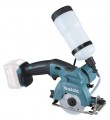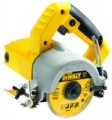Power source
The power source used by the electric tile cutter (see "Type").
-
Net. Mains power allows you to create a tool of almost any power with an essentially unlimited service life - as long as there is voltage in the outlet. At the same time, corded tools are noticeably cheaper and weigh less than their cordless counterparts. Their main drawback is the presence of a cord, which limits mobility and gets tangled underfoot. But dependence on sockets in most cases is not critical - tile cutters rarely have to be used where there is no electricity.
—
Battery. Battery power allows you to do without a power cord and allows you to work even in places where there are no outlets at all. However, the time of such work is limited, and you will still need an outlet to charge the battery; the situation can be partly corrected by having a replacement battery in stock, but not all tools allow for quick replacement of batteries. With all this, cordless tile cutters have relatively low power, and the weight and cost are significantly higher than that of a corded tool. As a result, this variety has not become particularly widespread; It makes sense to pay attention to such a tool when the absence of unnecessary wires is crucial.
Power
Rated motor power of the electric tile cutter. The more powerful the engine — the more force it can give to the cutting tool, the higher the rotation speed and disc diameter can be. Accordingly, a more
powerful tool is better suited for larger jobs and hard and/or thick materials. On the other hand, high power significantly affects the price, dimensions and weight of the tool, despite the fact that there is not always a real need for it.
In light of all this, it is necessary to choose a tile cutter in terms of power, taking into account the specifics of the intended use. So, in the case of a hand tool for simple household work, a power of 700 – 800 W is enough, more solid indicators may be required mainly for professional use. But in stationary units, where compactness does not really matter, you can not save on power — especially since such devices are usually used where performance is important.
Rotation speed
The maximum disc rotation speed provided by the motor of the electric tile cutter. Higher speeds are good for productivity, clean cuts and the ability to handle difficult materials, but they also require the right amount of power.
In general, if a tile cutter is bought for simple work with ordinary facing tiles (for example, repairs in an apartment), you can not pay much attention to this indicator: even the “slowest” models provide enough speed to cope with such tasks. But for cutting specific materials (for example, some types of stone), higher speeds may be required; detailed recommendations on this issue can be found in special sources.
Disc diameter
The nominal diameter of the cutting disc for which the electric tile cutter is designed. A disk of a larger diameter will simply not fit into the seat; but the use of smaller nozzles in some cases is allowed (but not recommended).
The depth of cut depends primarily on the diameter of the disc (see below). So, with ordinary tiles, having a thickness of up to 1.5 cm, almost any disc, even the smallest one, will cope; but for thicker materials (for example, paving slabs) and the appropriate tool will be needed. However it is worth noting that with the same diameter of the disc, the thickness of the cut may be different.
Also, the size of the cutting tool allows you to generally evaluate the class of the tool: the larger the disc, the more powerful and performant the tile cutter, usually.
Bore diameter
The diameter of the mounting hole on the cutting disc that the tile cutter is compatible with. This parameter is important when searching for and purchasing interchangeable working nozzles: the diameters of the mounting hole on the tile cutter and on the disk must match.
Cutting depth
The greatest depth to which the tool can cut through the material being processed, in other words, the maximum thickness of the tile that the tile cutter is guaranteed to be able to cut.
It is worth choosing a tool for this parameter taking into account the thickness of the material with which to work, plus some margin “just in case”. But this margin should not be too large: for a
deep cut, large discs and high power are required, which accordingly affects the price, weight and dimensions of the tool.
Battery platform
The name of the battery platform supported by the device. A single battery platform is used to combine various power tools of the same brand (screwdriver, grinder, circular saw, etc.) into one line. Devices belonging to the same platform use interchangeable batteries and chargers. Thanks to this, for example, there is no need to select a battery for each individual model of power tool, because one battery purchased as a spare can be used in various power tools, depending on the situation or as needed. Batteries of the same platform mainly differ from each other except in capacity.
Battery voltage
Operating voltage of the battery in a device with the appropriate type of power supply (see “Power source”). The more powerful the tool, the higher the battery voltage, as a rule. At the same time, this parameter is usually selected in such a way as to optimally match the characteristics of a particular model; therefore, in practice, voltage data may only be required when looking for a spare or additional battery.
Compatible batteries
Battery models with which the tile cutter of the corresponding type is compatible (see “Power source”). This information will be useful in cases where the battery(s) need to be purchased separately - for example, if the tool is not equipped with a battery at all, if you need to supplement the original package, or if the existing battery is faulty.

